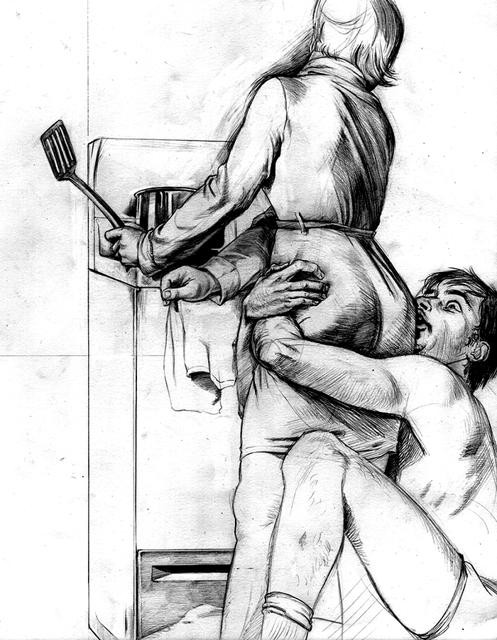Ambassadors of Asheville’s art scene took up residency in Atlanta for the past two months. Anna Jensen opened a solo exhibition at the Dockside Gallery and Gabriel Shaffer followed with a solo opening at Gallery 1526, a multifaceted arts collective in Candler Park. And over in Atlanta’s Armour Industrial District, a group of seven Asheville-based artists opened a group show at Mason Murer Fine Art, a 24,000-square-foot gallery space.
But despite their apparent synchronization and close proximity (just north of midtown and within two miles of each other), the three groups organized and opened independently of one another. It’s a prime example of our small-town art scene in flux — individual and groups of artists escaping the creative homestead while striving to stay put.
Asheville painter Julyan Davis organized and curated Drawing on the Unexpected: Works from Asheville Artists. He used connections with Mason Murer, where he’d shown his work in the past. The show consisted of 2-D works by Galen Frost Bernard, Larkin Ford, Alli Good, Brian Mashburn, Phillip McGuire, Daniel Nevins and Taiyo La Paix.
The idea sprang up when Davis saw La Paix’s paintings at Mars Hill College’s Weizenblatt Gallery. La Paix has shown nationally, as have many of the other artists. But Davis saw the rambunctious, stylized figures amid highway manifest-destined scenery as performing better in a larger urban outlet. If La Paix’s work could be transplanted, why not others?
Davis described the gallery as comparable to Blue Spiral 1, in that it hosts multiple, revolving exhibitions in several sub-galleries. The works hang beside contemporaries, placing the artists and our city in a greater Southern, if not national, scene.
“We’re using Mason Murer as a springboard,” Davis tells Xpress. Pieces are picked, packaged and sent off to new audiences and new collectors. It’s a Web-based alternative to traditional gallery representation. And it gives the art fresh eyes.
“Asheville is an excellent place to be based [as an artist],” says Davis, “but you have to have sensible representation.” Yet, it can be hard to adhere to a single model. Emphasis on the who, what, where and when of representation becomes the concern. Group shows in other cities, online outlets and traditional gallery representation are all viable means of selling work.
“When a group show goes to a bigger city, it enhances Asheville,” says Satellite Gallery owner and collector Bill Thompson. While selling is nearly always a goal for artists and gallerists, Thompson recognizes another form of success. “It’s not necessarily who’s selling the most, but where the interest lies,” he says.
Shaffer, whose exhibition is up through mid-April, shares these sentiments. It’s necessary to seek collectors outside of Buncombe, he says. “If it wasn’t for Los Angeles and New Orleans, I couldn’t live here.”
Collectors are key. Finding the right one(s) is the difficult part. They are here, after all, and they do buy artwork, Asheville artwork. But our city, which is much smaller than an Atlanta or a Los Angeles, is bursting at the seams with artists, not collectors.
“Artists have to be creative on all fronts,” Gary Byrd, a longtime Asheville artist and critic tells Xpress. The practice of creating tourist-friendly pieces harms both the artist and the work, he says. It’s the same commercialism that Davis is aiming to prevent by offering a mobile, group option.
“Making the work is the most important part,” Byrd says. Artists must cultivate their identities in order to cultivate a collector’s desires — this comes with regular critical dialogue and showing the work as much as possible. In regards to the elusive, if not endangered collector, don’t expect them to find locked-up artwork. “If it’s in storage, it’s dead,” he says. “If it’s on someone’s wall, it’s alive.”
“What makes a great art scene is knowing that your local art scene is important,” says Melanie Pierce, curator at Atlanta’s Gallery 1526. “But without the art of the entire world at your doorstep, you will burn out in your own flames.”
“We’re all used to this place (Asheville), and so we’re growing in response to one another,” Shaffer says. “You want more opportunities, and you want to grow as an artist, but you can only grow so much.”
This growth slows when the local base continues to show at the same galleries, without change and in rapid succession. Yes, it happens here in Asheville. “The scene becomes very flat-line and predictable,” Pierce says.
The big question or challenge for these artists and gallery owners: How can they create the circumstances for artists that live here to stay here? It warrants a dozen answers. But the baseline for this faction is to push the artwork outside of Asheville — continue to export the art, and you’ll import the serious buyers.




This article makes a good reply to all those local artists who were griping on Craig’s List recently.